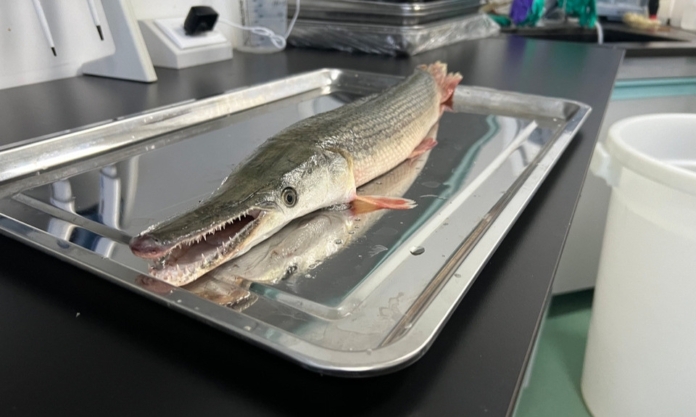Frankly, it’s terrifying. Were it to breed in large numbers, the consequences would be unimaginable. That’s what prompted authorities to take extreme measures to catch the beast. There are thought to even be some lurking in our very own Jiangsu Province.
When news emerged that the discovery of an alligator eel in Henan Province had caused the local government to empty an entire lake in order to eradicate the beast, it was picked up by media worldwide.
After it was first noticed by a local resident in mid July, local authorities began their capture operation of the 60-centimetre-long aquatic killer. It was to take a month of trying before they decided the last option was to drain the artificial Yunchan Lake.
So why the Jaws-like reaction? The alligator eel, also called an alligator gar in its native north America, has a long cylindrical body covered with fish scales that are thick and hard. Its upper and lower jaw are densely covered with two rows of dagger like teeth.
Zhuang Ping is former Director of the East China Sea Fisheries Research Institute of the Chinese Academy of Fishery Sciences. Speaking with The Paper, Zhuang explained that the alligator eel was initially introduced as a pet. However, being at the top of the freshwater food chain, if introduced it can bring disaster to an ecosystem.
Zhuang said, “It is a very ferocious fish, and its destructive power in the water cannot be underestimated. It will prey on other aquatic animals in large numbers and cause harm to local species”.
When Yunchan Lake was finally empty, some 37 million people watched online as the eel was tracked down.
Bizarrely, on that day, 26 August, there were three alligator eels caught in lakes across the country. In addition to that in Henan, others were caught in a lake in a residential community in Kunming City of Yunnan Province, and another in Changsha City of Hunan Province.
And the following day, two more in Qingdao City of Shandong Province, again after authorities had a lake drained.
While alligator eels can grow up to 1.5 metres in length and are undoubtedly scary to look at, there is no reason to believe they would be hostile to humans in their environment. In some parts of the US, game and fishery departments have put up notices to quell any fears; there have been no known attacks on humans.
It should also be noted that alligator eels are not suitable for consumption; their eggs are highly toxic.
Where do they come from in the wild? The general consensus is that after they grow too big as pets, people discard them into the nearest body of freshwater. If one was to there find a mate, it would be goodbye to the local aquatic environment. In China’s waters, there are very few fish more ferocious.









